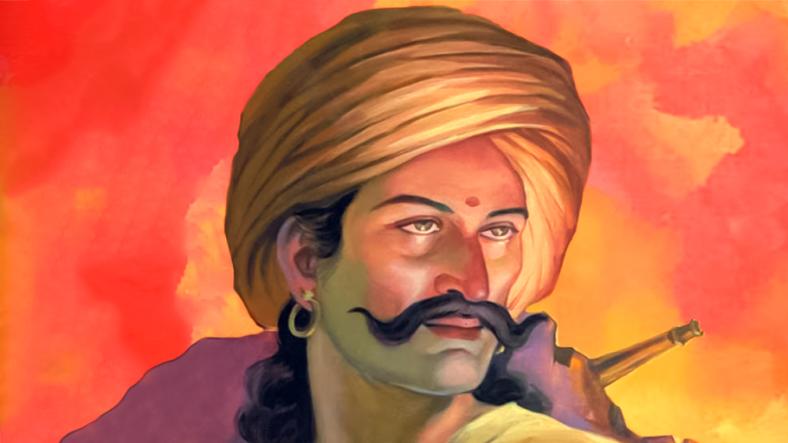Sangolli Rayanna: The Warrior Who Lit the Torch of Freedom

The Early Years: A Seed of Rebellion
Sangolli Rayanna Born on August 15, 1798, in the village of Sangolli in present-day Belagavi district, Karnataka, Sangolli Rayanna emerged from humble beginnings to become a symbol of resistance against British colonial rule.
From a young age, Rayanna was deeply influenced by the prevailing socio-political climate. The British East India Company’s aggressive expansion and the imposition of unjust policies sowed seeds of discontent among the local populace. Rayanna’s early experiences with these injustices ignited a fire within him, setting the stage for his future role as a freedom fighter.
Rise Through the Ranks: The Making of a Leader
Rayanna’s military acumen became evident as he rose through the ranks of the Kittur Kingdom’s army. His strategic brilliance and unwavering commitment earned him the position of senior commander under Rani Chennamma, the queen of Kittur.
His leadership was characterized by a deep sense of duty and an unyielding spirit. Rayanna’s ability to inspire his troops and his tactical prowess made him a formidable force against the British. His dedication to the cause of freedom was not just a duty but a personal mission, reflecting his profound connection to his land and people.
The 1824 Rebellion: A Stand Against Oppression

In 1824, the British East India Company’s Doctrine of Lapse threatened to annex the Kittur Kingdom, citing the lack of a male heir. Rani Chennamma, with Rayanna’s unwavering support, led a rebellion against this unjust policy.
The rebellion, though ultimately suppressed, marked a significant moment in India’s resistance against colonial rule. Rayanna’s role in this uprising showcased his strategic brilliance and his deep commitment to justice. His actions during this period solidified his reputation as a fearless leader willing to challenge the might of the British Empire.
Guerrilla Warfare: The Unyielding Spirit
Following the suppression of the 1824 rebellion and the execution of Rani Chennamma, Rayanna continued the fight through guerrilla warfare. Operating in the dense forests and rugged terrains of Karnataka, he led a band of dedicated followers in a relentless campaign against British forces.
Rayanna’s guerrilla tactics were innovative and effective. He targeted British administrative centers, disrupted supply lines, and inspired local populations to resist colonial rule. His ability to evade capture and sustain the resistance made him a thorn in the side of the British authorities.
Capture and Martyrdom: The Ultimate Sacrifice
Despite his strategic brilliance, Rayanna was eventually captured in 1830, and betrayed by those he trusted. He was tried and sentenced to death by hanging, a punishment carried out on January 26, 1831, near Nandagad in Belagavi district.
Rayanna faced his execution with dignity and courage. His final words echoed his unbreakable spirit and his unwavering commitment to India’s freedom. His martyrdom became a rallying point for future generations, symbolizing the sacrifices made in the pursuit of independence.
Legacy: Inspiring Generations
Sangolli Rayanna’s legacy endures in various forms across Karnataka and India. His life and sacrifices are commemorated through statues, songs, and educational institutions.
In Bengaluru, the main railway station has been renamed Kranti Veera Sangolli Rayanna Railway Station, honoring his contributions to India’s freedom struggle.
A military school named after Rayanna is being established in Karnataka, aiming to instill his values of courage and patriotism in future generations.
Cultural Depictions: Keeping the Flame Alive
Rayanna’s life has been immortalized in various cultural forms, including the Kannada-language film “Kranti Veera Sangolli Rayanna,” which portrays his heroic deeds and unwavering commitment to freedom.
Folk songs and ballads continue to celebrate his bravery, ensuring that his story remains alive in the hearts and minds of the people.
Conclusion: A Beacon of Resistance
Sangolli Rayanna’s life is a testament to the power of resilience and the enduring spirit of resistance against oppression. His unwavering commitment to justice and freedom continues to inspire generations, reminding us of the sacrifices made in the pursuit of a free and just society.






![Title: The Life and Journey of Ryan Watts: A Rising Star in [Industry/Sports/Tech/Entertainment] Ryan Watts](/wp-content/uploads/2025/04/convert-4-1-390x220.webp)